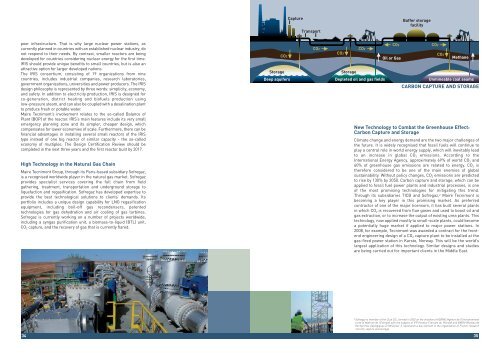FACTS & FIGURES - Tecnimont ICB
FACTS & FIGURES - Tecnimont ICB
FACTS & FIGURES - Tecnimont ICB
You also want an ePaper? Increase the reach of your titles
YUMPU automatically turns print PDFs into web optimized ePapers that Google loves.
poor infrastructure. That is why large nuclear power stations, as<br />
currently planned in countries with an established nuclear industry, do<br />
not respond to their needs. By contrast, smaller reactors are being<br />
developed for countries considering nuclear energy for the first time.<br />
IRIS should provide unique benefits to small countries, but is also an<br />
attractive option for larger developed nations.<br />
The IRIS consortium, consisting of 19 organizations from nine<br />
countries, includes industrial companies, research laboratories,<br />
government organizations, universities and power producers. The IRIS<br />
design philosophy is represented by three words: simplicity, economy,<br />
and safety. In addition to electricity production, IRIS is designed for<br />
co-generation, district heating and biofuels production using<br />
low-pressure steam, and can also be coupled with a desalination plant<br />
to produce fresh or potable water.<br />
Maire <strong>Tecnimont</strong>’s involvement relates to the so-called Balance of<br />
Plant (BOP) of the reactor. IRIS’s main features include its very small<br />
emergency planning zone and its simpler, cheaper design, which<br />
compensates for lower economies of scale. Furthermore, there can be<br />
financial advantages in installing several small reactors of the IRIS<br />
type instead of one big reactor of similar capacity - the so-called<br />
economy of multiples. The Design Certification Review should be<br />
completed in the next three years and the first reactor built by 2017.<br />
High Technology in the Natural Gas Chain<br />
Maire <strong>Tecnimont</strong> Group, through its Paris-based subsidiary Sofregaz,<br />
is a recognised worldwide player in the natural gas market. Sofregaz<br />
provides specialist services covering the full chain from field<br />
gathering, treatment, transportation and underground storage to<br />
liquefaction and regasification. Sofregaz has developed expertise to<br />
provide the best technological solutions to clients’ demands. Its<br />
portfolio includes a unique design capability for LNG regasification<br />
equipment, including boil-off gas recondensers, patented<br />
technologies for gas dehydration and air cooling of gas turbines.<br />
Sofregaz is currently working on a number of projects worldwide,<br />
including a syngas purification unit, a biomass-to-liquid (BTL) unit,<br />
CO 2 capture, and the recovery of gas that is currently flared.<br />
CO2<br />
Storage<br />
Capture<br />
Transport<br />
CO2<br />
CO2<br />
Storage<br />
CO2<br />
Oil or Gas<br />
Buffer storage<br />
facility<br />
Methane<br />
Deep aquifers Depleted oil and gas fields Unmineable coal seams<br />
CARBON CAPTURE AND STORAGE<br />
34 35<br />
CO2<br />
CO2<br />
CO2<br />
New Technology to Combat the Greenhouse Effect:<br />
Carbon Capture and Storage<br />
Climate change and energy demand are the two major challenges of<br />
the future. It is widely recognised that fossil fuels will continue to<br />
play a central role in world energy supply, which will inevitably lead<br />
to an increase in global CO 2 emissions. According to the<br />
International Energy Agency, approximately 69% of world CO 2 and<br />
60% of greenhouse gas emissions are related to energy. CO 2 is<br />
therefore considered to be one of the main enemies of global<br />
sustainability. Without policy changes, CO 2 emissions are predicted<br />
to rise by 130% by 2050. Carbon capture and storage, which can be<br />
applied to fossil fuel power plants and industrial processes, is one<br />
of the most promising technologies for mitigating this trend.<br />
Through its subsidiaries T<strong>ICB</strong> and Sofregaz, 2 Maire <strong>Tecnimont</strong> is<br />
becoming a key player in this promising market. As preferred<br />
contractor of one of the major licensors, it has built several plants<br />
in which CO 2 is recovered from flue gases and used to boost oil and<br />
gas extraction, or to increase the output of existing urea plants. This<br />
technology, now applied mostly to small-scale plants, could become<br />
a potentially huge market if applied to major power stations. In<br />
2008, for example, <strong>Tecnimont</strong> was awarded a contract for the frontend<br />
engineering design of a CO 2 capture plant to be installed at the<br />
gas-fired power station in Karsto, Norway. This will be the world’s<br />
largest application of this technology. Similar designs and studies<br />
are being carried out for important clients in the Middle East.<br />
2 Sofregaz is member of the Club CO2, formed in 2002 on the initiative of ADEME (Agence de l’Environnement<br />
et de la Maitrise de l’Energie) with the support of IFP (Institut Français du Pétrole) and BRGM (Bureau de<br />
Recherches Géologiques et Minières). It represents a key element in the organization of French research<br />
into CO 2 capture and storage.





